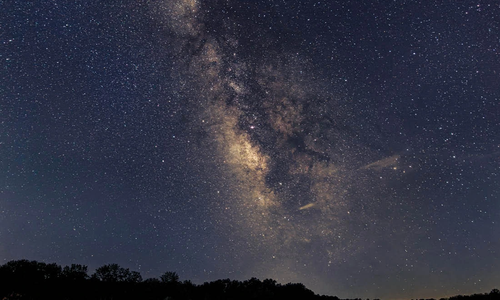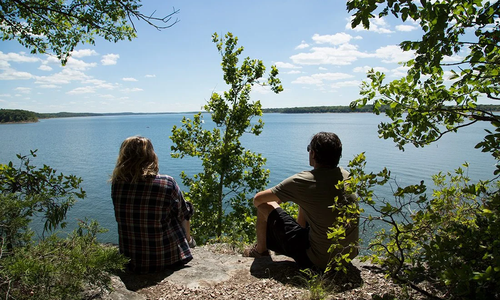Outdoors
All the Ways to Enjoy the Wilderness in the Ozarks
Explore the wild spaces of the Ozarks and find out more about how you can get involved in local conservation efforts.
by Vivian Wheeler, additional reporting by Katie Pollock Estes
Oct 2024

Choose a Section
Imagine a morning in the Ozarks: The sun rises over rolling hills, casting a golden glow across sparkling streams and lush forests. The air is fresh and crisp, and the beauty of our natural landscapes invites us to explore and enjoy them.
Preservation and conservation of these scenic places are not just lofty ideals. They are essential to maintaining the health and beauty of the places we cherish. Our actions today ensure that future generations can experience the same clear waters, vibrant prairies and diverse wildlife that we enjoy today.
When others step up to conserve our environment, they are working to keep these landscapes pristine and accessible for everyone. Whether it’s through cleaning up rivers, protecting prairies or managing wildlife habitats, their efforts help preserve the very essence of what makes our region unique. Read on to learn about the work being done to preserve our natural landscapes and resources and how you can get involved. Then plan your perfect day out exploring these wonders of the Ozarks.
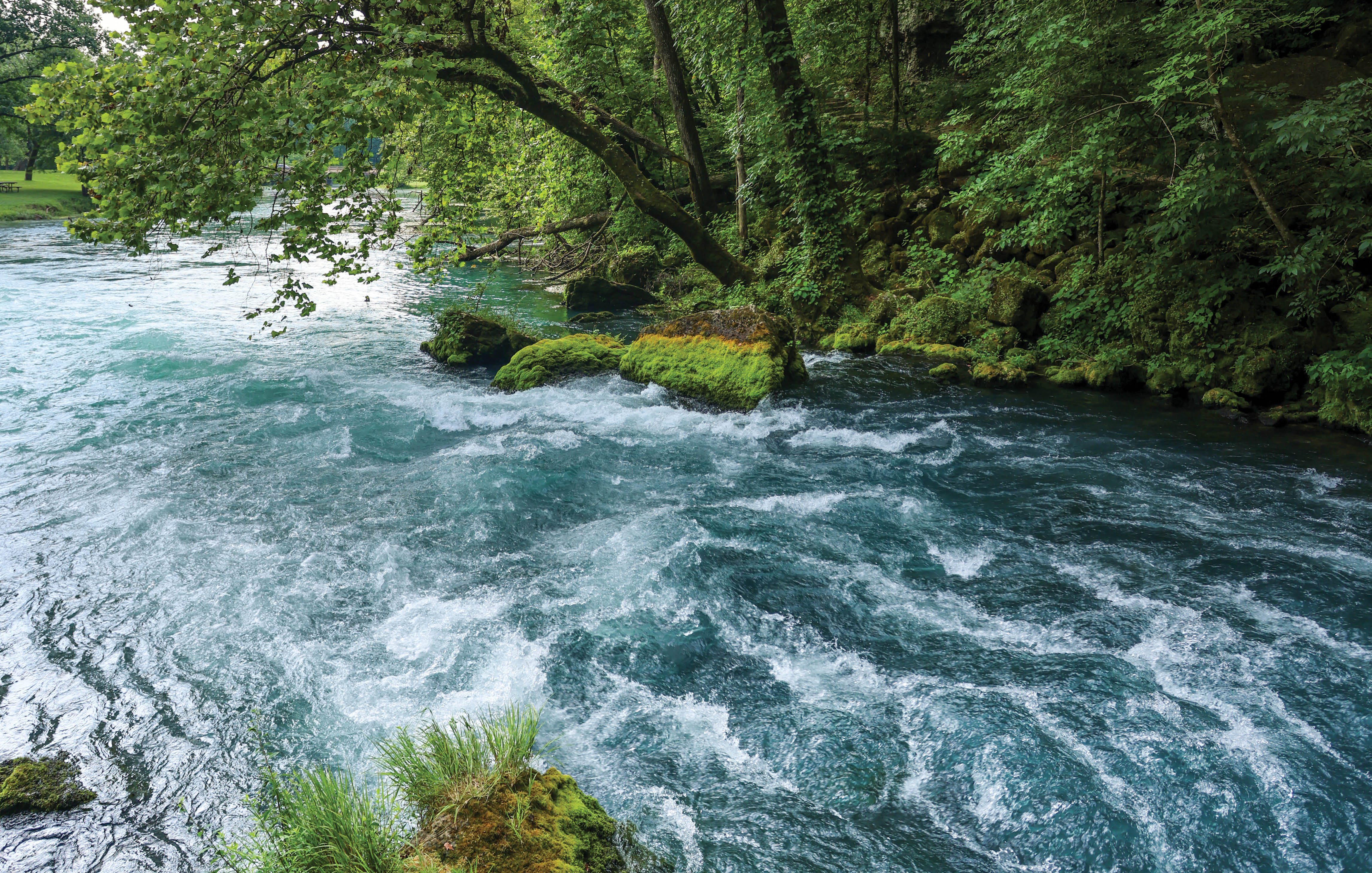
Ozarks Waterways
Here in the Ozarks, it can be easy to take water for granted. There are clear streams, cold springs and beautiful lakes all over the region. We’re lucky enough to have one of the most abundant groundwater supplies in the country, and our region’s unique geography means much of that water makes its way to the surface. Over thousands of years, the Springfield aquifer has created cracks and crevices in the soft dolomite and limestone rocks, allowing pathways for water to flow topside, where we get to use and enjoy it.
Although the Ozarks has abundant and clean water, there’s a lot of work that goes into protecting it and ensuring it remains that way. According to Michael Kromrey, the executive director of the Watershed Committee of the Ozarks, the two macro issues facing our water systems are population growth and climate change.
To understand the real-world impact of these issues, let’s turn back the clock to the early 1990s. Back then, there was a series of algae blooms in Table Rock Lake. Specifically, the James River arm of Table Rock Lake.
Algae blooms are detrimental to the health of water. “When you have an algae bloom, that algae will eventually die. And when it dies, the process of decomposition sucks all the oxygen out of the water,” says Brent Stock, executive director of the James River Basin Partnership (JRBP). These algae blooms are the reason the JRBP was formed in 1997. “Since then we’ve seen a pretty dramatic transformation in water quality in the James River,” says Stock. Stock credits those improvements mainly to increased regulation and improvements to point-source pollution—pollution from a specific source, such as a feedlot or water treatment facility.
Today, the organization continues its mission of improving and protecting the water quality of the springs, streams, rivers and lakes in the James River watershed, which consists of almost a million acres of land. The JRBP does this through a variety of initiatives, including educational programs, river cleanups, septic system management and methods for riparian corridor protection.
Riparian corridors are vegetated borders along water sources, and they play a huge role in water quality in both our rivers and our lakes. Take for example Table Rock Lake. The lake was built as a reservoir by the U.S. Army Corps of Engineers in 1959. One of the biggest challenges the Corps faces is balancing recreation with conservation. As as development increases, the need for riparian corridors becomes more important. This is why the Corps has building guidelines in place for Table Rock Lake. Often people want to cut down trees for a better view or clear cut their lawns all the way to the water’s edge. But these actions destroy the natural vegetation that helps secure the shoreline, filter pollutants and prevent erosion. “We have to make sure we’re going to give the region another 50 years of use, if not longer, at Table Rock Lake.” Townsend says.—Vivian Wheeler

How You Can Help Maintain Our Waterways
Volunteer for a Cleanup
Participate in James River Basin Partnership’s major cleanup events like River Rescue and the Earth Day cleanup at Lake Springfield. To see even more opportunities, sign up for the JRBP newsletter. They send out a list of ways to get involved every quarter. You can sign up on the website.
Become a Sustainer
If you’re short on time, consider becoming a Watershed Sustainer and supporting clean water through automatic monthly or yearly donations. Join online.
Where to Get on the Water
Enjoy the crystal-clear rivers of the Ozarks with these three essential fall float trips.
Vistas Around Every Bend
Waterway: Buffalo National River
Float: Tyler Bend to South Maumee
Why You’ll Love It: Along this 17.5-mile float, the river’s trademark towering bluffs line the waterway and are accented by gorgeous fall color.
Spring-fed Scenery
Waterway: Current River
Float: Akers Ferry to Pulltite
Why You’ll Love It: The water is clear and floatable year-round hanks to numerous freshwater springs that feed into the Current River—which is part of the Ozark National Scenic Riverways. You can even float your canoe right up to the opening of Cave Spring!
An Anger’s Dream
Waterway: Niangua River
Float: Bennett Spring to Mountain Creek
Why You’ll Love It: In addition to being surrounded by fall color and lighter crowds than in the summer, you can also reel in a few fish during your day on the water. The Niangua is a great fishing destination, and the hatchery at nearby Bennett Spring State Park makes a great side trip.—Katie Pollock Estes

Prairies and Grasslands
Taking a look at Missouri today, you wouldn’t think that once upon a time, nearly a third of our state was covered in prairie. “There used to be 15,000,000 acres of prairie in our state,” says Carol Davit, the executive director of the Missouri Prairie Foundation. “Today we have fewer than 45,000 acres of unplowed prairie.” Davit has been working to protect Missouri’s remaining prairie since 1996, when she started as a volunteer for the organization, but her love of nature and passion for conservation began much earlier.
Davit grew up on the grounds of Shaw Nature Reserve, which is about 40 minutes southwest of St. Louis, where both of her parents worked. Davit’s father was a naturalist at the reserve. Part of his job included collecting seeds from prairie remnants, propagating them, and planting them to create new prairie. Her mother did a variety of jobs, including germinating and propagating rare plants. Considering her upbringing, it’s easy to see how Davit has become such a passionate advocate for Missouri prairie. “Prairies are so important to our economic—and therefore our cultural—history,” she says.
Prairie plants have incredibly deep root systems and every year a third of them die. Over thousands of years, those decaying roots created incredibly rich, nutrient-dense soil, which ultimately contributed to the demise of Missouri prairies. Due to the rich soil, much of our prairielands were converted to agricultural land, and with that came a loss of biodiversity.
Prairies contain incredible biodiversity. In 2020, botanist Brett Budach recorded 46 species within a 20-by-20 inch square at Penn-Sylvania Prairie, one of the prairies the foundation oversees. To Davit’s knowledge, this is a world record.
The Missouri Prairie Foundation works to preserve original, unplowed prairie while also establishing new planted prairies. Protecting prairies is not a passive task.
“Prairie needs assertive stewardship,” says Davit. To help combat invasive species, the Foundation executes controlled burns over a third of their prairies each year. Additionally, the foundation promotes native species through its Grow Native! program. Grow Native! helps increase conservation awareness of native plants and their effective use in urban, suburban and rural developed landscapes.
Protecting and preserving our prairies is no small task, but Davit chooses to see the glass as half-full. “We’ve lost so much, and it’s a staggering loss,” she says. “But we can also say ‘Isn’t it amazing that through all this human development in the past 200 years, these remnants exist?’ Let’s celebrate that they still exist and protect them.”—Vivian Wheeler

How You Can Help
Build a Butterfly Garden
Grow Native! has a free butterfly garden design full of native plants on their website.
Bring Your Camera
Whether you’re driving by to enjoy the view or trekking into the tall grasses, the protected and restored prairielands around southwest Missouri are home to abundant and varied wildlife and photo-worthy vistas.
Kickapoo Edge Prairie Garden
Nearest town: Springfield
You can experience the work of the Missouri Prairie Foundation right here in 417-land at the Kickapoo Edge Prairie garden at the Springfield Botanical Garden. This small prairie garden contains more than 50 native species and is maintained using controlled burns.
La Petite Gemme Prairie
Nearest town: Bolivar
You can view this Missouri-designated Natural Area as you walk or cycle along the Frisco Highline Trail. It’s located at Mile 32 of the trail and features 335 native plants that can explode with the colors of wildflowers during the spring and blow in the breeze all autumn long.
Prairie State Park
Nearest town: Mindenmines
There are vast swaths of tallgrasses and loads of native bird species here (plus designated walking paths that make it easy to explore). But the most majestic animals are in the resident bison herd. Visit the Regal Tallgrass Prairie Nature Center while you’re there.
Stony Point Prairie Conservation Area
Nearest town: Lockwood
In addition to 960 acres of prairie lands that are home to numerous types of native flora, this spot is also great for fishing at a handful of on-site ponds. Stony Point is part of an Audubon Society –designated “Important Bird Area.” Tons of birds live there, like the Greater Prairie Chicken, Eastern Meadowlark, short-eared owl and upland sandpiper.—Katie Pollock Estes
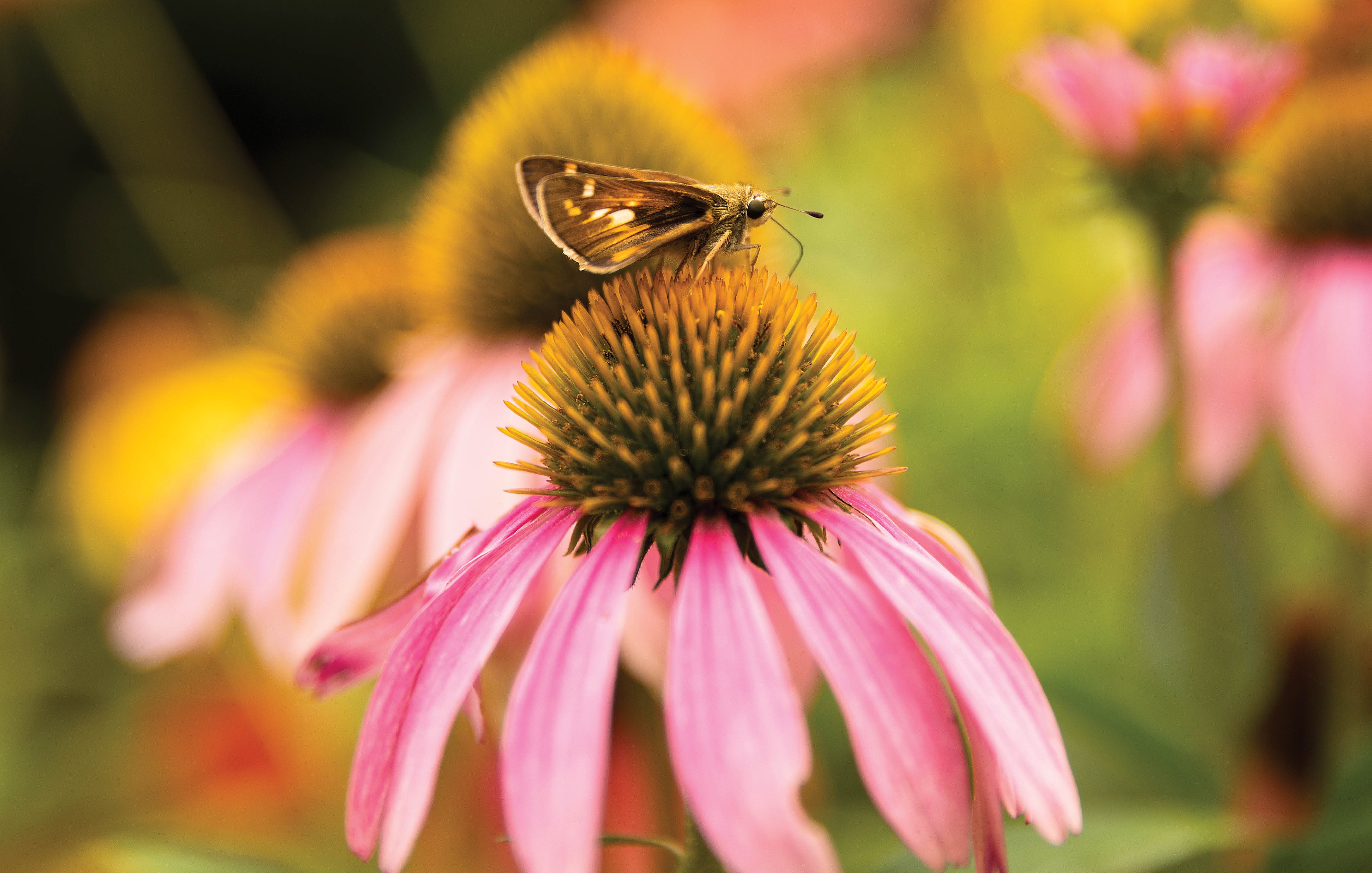
Ozarks Wildlife
We share the ozarks’ beautiful spaces with a lot of flora and fauna. The same places where we want to hike, boat and play are also home to unique animals. “If I were to sum it up in one sentence, the major issue facing our wildlife is folding human uses and needs into the landscape with wildlife uses and needs,” says Francis Skalicky, Missouri Department of Conservation’s southwest regional media specialist. We sat down with him to discuss our local wildlife, the issues impacting it, what’s being done to preserve it and how you can help.
Some of the local critters most in need of protection are native pollinators. Pollinators play a huge role in our economy. A 2010 Cornell University study found that the pollinating activities of insects contributed $29 billion each year to the U.S. agricultural economy.
So what’s the solution? We need to reduce the number of pesticides we use and increase the amount of native plants available to pollinators.
Here’s where you come in. You can help lead the charge by incorporating native plants into your landscaping and gardens at home. “Whatever you plant in the way of native plants is more than these insects had before,” says Skalicky. “It’s that much more habitat. Your big fields of milkweed, we know those make a difference, but your little flower gardens, the plants you have on the side of your driveway, they all make a difference.”
Pollinators aren’t the only animals affected by the lifestyles of the humans around them.—Vivian Wheeler
Pollinators
The issue: The populations of many of our bees and butterflies are in a state of concern. Pollinators play a huge role in our economy. A 2010 Cornell University study found that the pollinating activities of insects contributed $29 billion each year to the U.S. agricultural economy.
The solution: We need to reduce the number of pesticides we use and increase the amount of native plants available to pollinators.
How you can help: Plant native plants. “Whatever you plant in the way of native plants is more than these insects had before,” says Skalickly. “It's that much more habitat. Your big fields of milkweed, we know those make a difference, but your little flower gardens, the plants you have on the side of your driveway, they all make a difference.”
Chronic Wasting Disease
The issue: Chronic Wasting Disease (CWD) is an always-fatal disease of the nervous system that affects cervids. In Missouri, that mainly means whitetail deer. If the disease goes unchecked, it could severely impact the deer population in Missouri. Currently there is not a cure for CWD. Since 2012, when the first case was documented, 572 cases have been confirmed.
The solution: The MDC works to control the spread of the disease through sampling and targeted removal.
How you can help: If you’re hunting within the CWD management zone, be sure to follow MDC’s guidelines. The guidelines include mandatory testing for certain counties, a prohibition of consumable products used to attract deer, carcass movement restrictions, and more. You can find all of the guidelines on the MDC website.
Hydrilla
The issue: Hydrilla is an invasive aquatic plant that forms thick vegetative mats. These vegetative mats destroy aquatic habitats and can cause serious damage to municipal water centers.
The solution: There is a hydrilla-specific herbicide that can effectively eliminate the plant. The MDC has found 37 cases of hydrilla since 2017, and today there are only 5 active sites that are still being treated. “Hydrilla is a conservation battle we’re winning,” says Skalicky. “This looks like something that we can actually eliminate from this area in Missouri.”
How you can help: Hydrilla was introduced through improper aquarium dumping. Be sure to dispose of aquariums properly. Also, the plant can attach itself to boats. Before leaving a boating area, your boat should be properly cleaned and dried, so as not to spread the plant to uninfected areas.
Turkey Habitats
The issue: Currently, Missouri and much of the U.S. are seeing a decline in the turkey population. In order for turkey populations to thrive, they need habitats suitable for nesting and brood-rearing. These habitats are disappearing, which is driving down the turkey population.
The solution: Create more suitable habitats for turkeys. The MDC is working to increase these habitats through their Turkey Habitat Initiative, which is an ongoing series of workshops with landowners to teach them how to create better turkey habitats.
How you can help: Attend a turkey habitat improvement workshop. These events can be found on the MDC website.
Preserving Ozarks Beauty for Future Generations
The Johnny Morris Conservation Foundation is based in Springfield but has impact on the future of the whole region.
You’ve probably spent a day wandering Wonders of Wildlife, Top of the Rock Ozarks Heritage Preserve or Dogwood Canyon Nature Park, but did you know that these spots are more than just local attractions? Preserving and protecting the natural beautify of these Ozarks hills and the world beyond is at the heart of the Johnny Morris Conservation Foundation, which built and maintains these popular spots.
Of these three attractions, Dogwood Canyon Nature Park (Lampe) is the one that feels the most like an Ozarks moment frozen in time. At 10,000 acres, it offers plenty of space for the casual visitor to explore on foot or via bike, horseback or tram. Guests can sign up for guided fly fishing or wildlife tours or simply explore on their own, making a stop at the park’s Conservation and Education Center. But either way, this spot filled with sparkling streams, tumbling waterfalls and rocky bluffs feels like a world apart—all of it protected and all of it pristine.
At Top of the Rock Ozarks Heritage Preserve (Ridgedale), the sweeping views of Table Rock Lake and the hills beyond are irresistible—especially at sunset. The property’s cave and sinkhole give visitors a look at the effect karst topography has on the region, while a sprawling golf course offers a more manicured view. Also on site is the Ancient Ozarks Natural History Museum, an enormous private collection of Native American artifacts.
And finally, Wonders of Wildlife National Museum & Aquarium (Springfield) has been voted America’s Best Aquarium multiple times by USA Today readers. And although visitors can watch ocean creatures swim through the water in immersive displays at this 350,000-square-foot museum, the aquarium is also grounded in the Ozarks with exhibits that bring to life the wildlife that live in our freshwater rivers and the sport of fishing. On the natural history side of the facility, beautifully produced 4-D dioramas show off wildlife from nearby and around the world using sensory effects including sounds and smells.—Katie Pollock Estes

Josh Wisdom
Josh Wisdom has a pretty darn cool job title. He’s a wildlife damage biologist. Essentially this means he tries to mitigate the friction between wild animals and humans, especially when it comes to bears. After being nearly extirpated from the state in the 1900s, bears have seen a slow resurgence starting in the 1960s. We sat down with him to discuss the bear population in Missouri.
417 Magazine: What is the population of black bears in Missouri today?
Josh Wisdom: We have roughly 1,000 bears in Missouri, and we’re growing at a rate of 8% to 9% a year. Which means the bear population will essentially double every 10 years.
417: How can people prevent run-ins with bears?
J.W.: Bears are really just big raccoons. Whatever a raccoon would get into, is also what would attract a bear. So bird feeders, outdoor pet food, leaving a trash bag outside. All of these things could attract a bear to your house.
417: What should someone do if they encounter a bear?
J.W.: Make sure they know you’re there. If a bear stands up, it means they’re trying to figure out what you are and that’s a good time to wave your hands and yell. Give them plenty of space, but almost always if a bear knows you’re there, he’s going to be heading the other direction. Check out the BearWise website for more information.—Vivian Wheeler
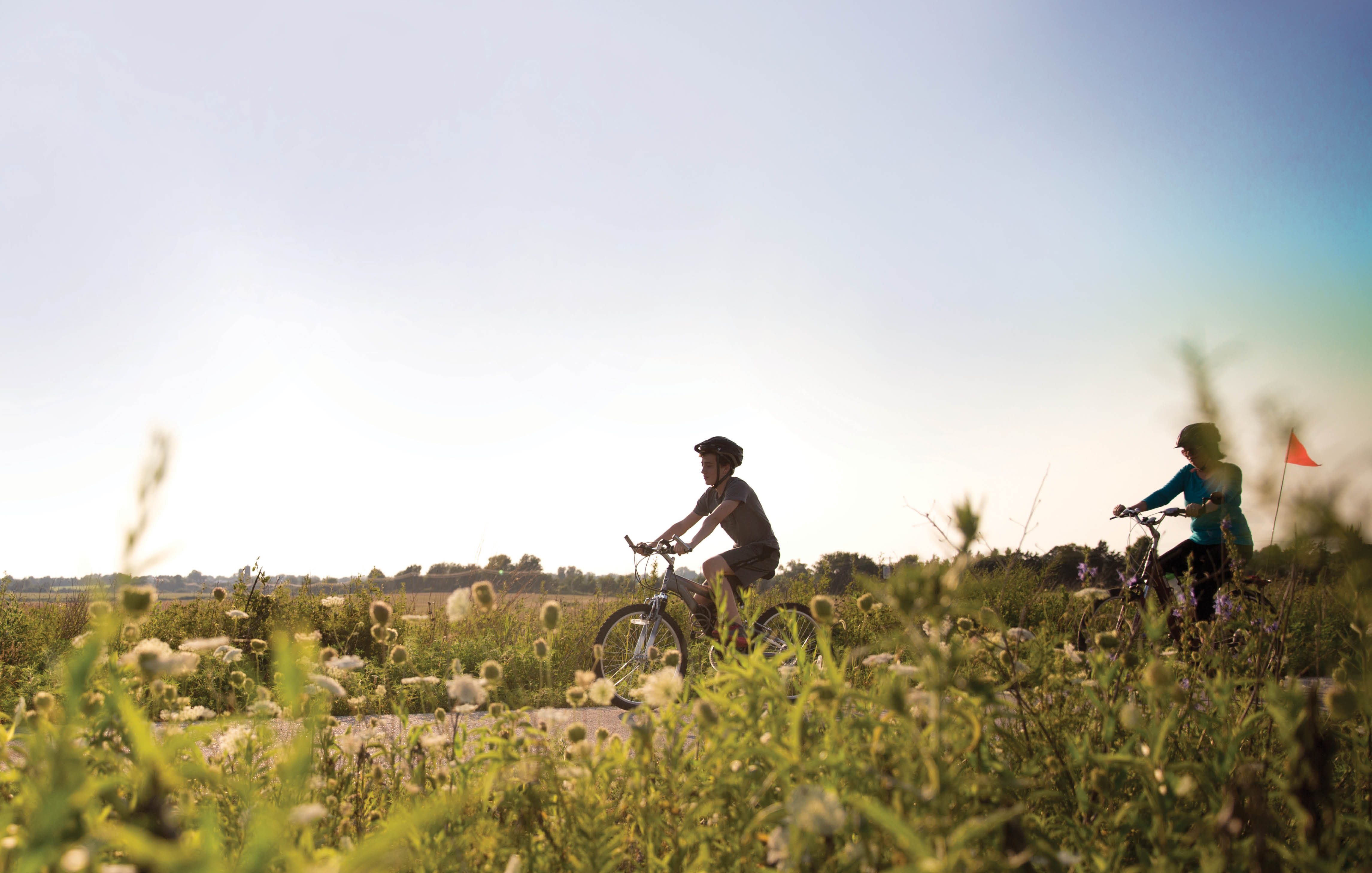
Trails in the Ozarks
Across our region, there are hundreds of miles of trails. Gravel trails, dirt trails, concrete trails and asphalt trails criss-cross 417-land, and a lot of people assume that those trails are maintained by the city or county. Rather, they are funded, built and maintained by an ecosystem of stakeholders, made up of nonprofits, governmental organizations and volunteers. For Alaina Grote, executive director of the nonprofit TrailSpring, the biggest obstacle her organization faces is a lack of education about how it all works.
It takes a lot of different groups working together to maintain and grow our trail system here in the Ozarks. “Funding is definitely a huge challenge, but if you don’t have collaboration, and if you don’t have coordination, then you can’t get anything done,” says John Montgomery, the interim director of Ozark Greenways.
Take for example the Dirt 66 project at Fellows Lake that was completed in the summer of 2022. The ultimate goal of Dirt 66, which is a TrailSpring initiative, is connecting 66-plus miles of multi-use trails around northern Springfield, and the Fellows Lakes trails make up 26 miles of the project.
This project came to life thanks to a partnership between TrailSpring, City Utilities (CU) and Ozark Greenways. TrailSpring, which focuses on natural trails, handled the funding and oversaw the construction of the trails. Meanwhile, Ozark Greenways assisted with project management and is the trail coordinator. They also keep up with trail maintenance through a mix of staff and volunteers, funded by a combination of their annual budget and specific grants. CU owns the trails, which are located on their property around Fellows Lake, a major source of drinking water for the community.
Each group brings something to the tablet. So, what’s on the horizon? The Ozark Greenways is currently focused on the Chadwick Flyer Trail, which will connect Sunshine Street in Springfield to the Ozark Community Center in Christian County. They are working with the City of Springfield, who is working with BNSF Railway to obtain land from a former railroad. They hope for money from the American Rescue Plan Act (ARPA) funds to complete the project. If all goes to plan, the trail will be 12 miles long and will be completed in 2026.
The City of Springfield is also spearheading exciting projects. They were recently awarded a $25 million RAISE grant that will fund an extension of the Wilson’s Creek Greenway, Jordan Creek Greenway and Trail of Tears Greenway.
For TrailSpring, they are continuing to work on their Dirt 66 project—as well as a pump track project. “A pump track is kind of like a small bike park,” says Grote. “Usually it’s in an urban space, which is what we’re going for. Not everybody has the resources to get a mountain bike or reliable transportation to get all the way out to Fellows Lake or Two Rivers. So we wanted to focus on bringing a little bit of the outdoors to a more main part of town.”—Vivian Wheeler

How You Can Help
Adopt a Trail
Ozark Greenways has an Adopt-a-Trail program at Fellows Lake where people can get engaged on a long term basis on managing a specific section of that trail and doing that annually. Find more info from Ozark Greenways.
Get Your Heart Pumping
We can talk and write about trails all day—but experiencing them is a whole lot more fun! These Missouri and Northwest Arkansas trails come alive in the fall, with bursting color and beautiful views.
For a Trek on Two Wheels
Dirt 66 and Two Rivers Mountain Bike Park
One of the newest mountain biking trail systems in the Springfield area, Dirt 66 offers 25 miles of natural-surface paths with views of the area all around Fellows Lake. Pick a loop, and go exploring! They range in length from 0.14 miles to 4.5 miles long. In nearby Highlandville, Two Rivers Mountain Bike Park features 14 miles of professionally designed trails that can be enjoyed by hikers as well as bikers.
For Super-Easy Access
The Red Trail at Busiek State Forest and Wildlife Area
If you live in Springfield, you can be on the red trail less than 30 minutes after walking out your front door. The 3-mile loop passes the Carter Family Cemetery that’s more than 130 years old and at least one water crossing (wear waterproof boots). And every step of the way you’ll be engulfed in the changing colors of fall.
For Otherworldly Rocks
Pedestal Rocks Trail
At only 2.2 miles long, this hiking trail isn’t too strenuous—and the payoff is excellent. You’ll get to gaze out over an expansive valley and see huge rock formations jutting up above the trees. It’s quite a sight any time of year, but it’s especially nice with a backdrop of orange leaves.—Katie Pollock Estes
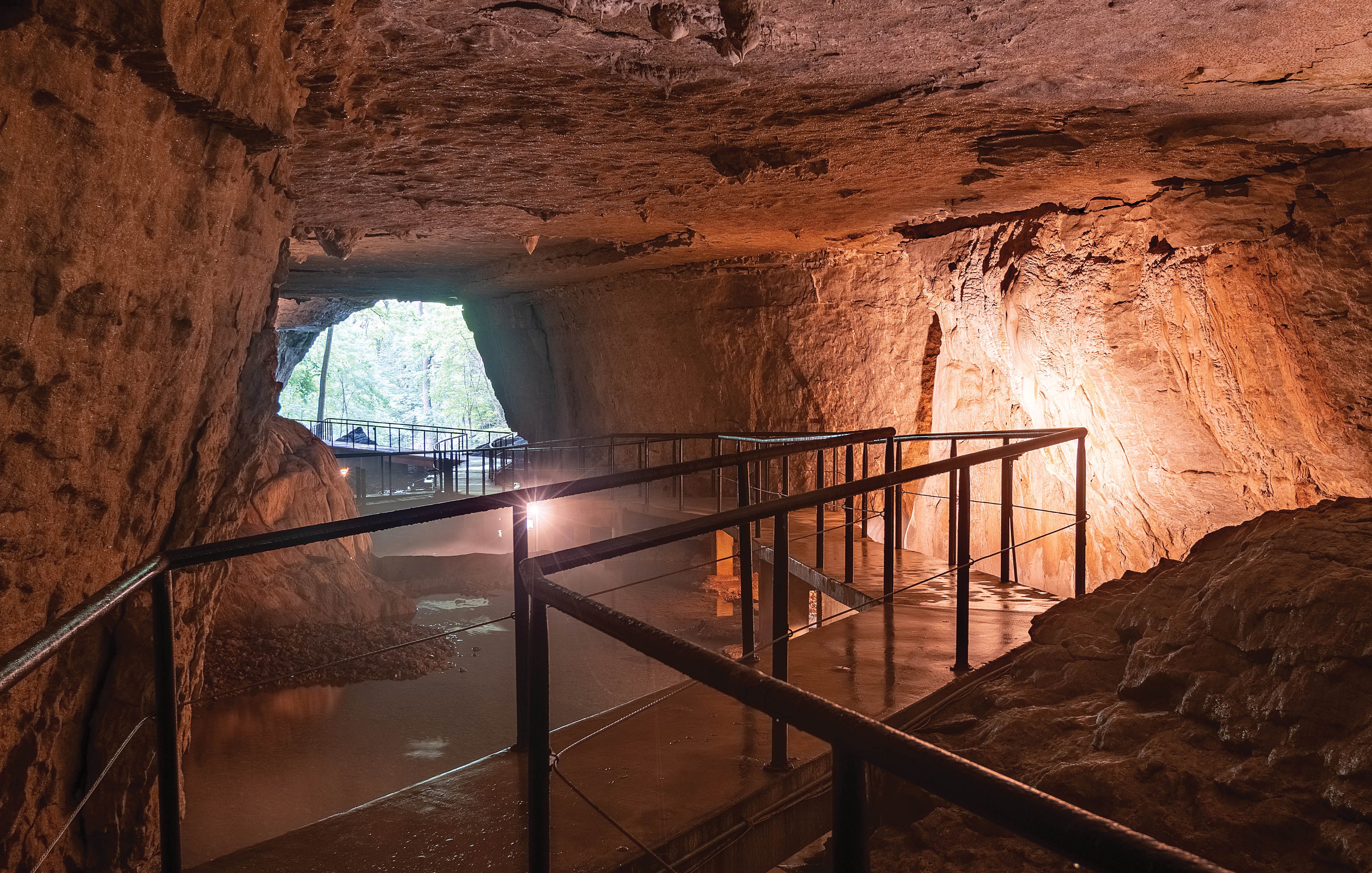
Ozarks Caves
If you’re reading this, there’s a pretty good chance you’ve seen a crayfish (crawdad for us country folk) in the wild. Heck, there’s a pretty good chance that you’ve even caught a crayfish. But we bet most of you have not seen a bristly cave crayfish. That’s because they only live in caves in nine counties in Missouri and Arkansas. These cave-adapted crayfish look like ghosts. They’re translucent. So translucent you can see food pass through their bodies. One of those nine counties happens to be Christian County. For the price of an admission ticket, you can see one of these rare creatures at Smallin Cave in Ozark.
Smallin Cave is a commercial cave owned by Kevin and Wanetta Bright. For the couple, owning a commercial cave started out as a pipe dream. With a lot of hard work, some luck and a healthy dose of persistence, it eventually became their American dream. “The American dream of owning a small business, being successful and passing it along to your family—a commercial cave is that,” Kevin says. “But it comes with a lot of responsibility. It’s a resource that has to be cared for.” Bright and his wife, Wanetta, purchased the cave in 2009 from a church. The land the cave sits on was a church camp for years.
The first few years were tough ones. There was a lot of work that needed to be done before they could officially open for tours. Eight months after they bought it, and not a moment too soon, the cave opened for tours in April of 2010. For the next decade things ran relatively smoothly. The Brights were living their American dream. Then two years ago, they began noticing silt and sediment in what had been a crystal-clear stream bed in Smallin Cave. Since then, it’s only gotten worse. In July of 2024 there was a big storm that dumped a ton of silt into Smallin Cave. One of the problems with excess silt is that it covers the gravel bed of the stream that flows through the cave. Without the ability to hide in the gravel, the bristly cave crayfish are sitting ducks for predators, like raccoons.
When the Brights started noticing silt in their cave, they reached out to the Ozarks Underground Labs (OUL) for help. OUL is a consulting company that does hydrogeological investigations all over the world, specializing in karst geography. OUL uses dye tracing to track where water comes from and where it ends up. The company determined the silt in Smallin Cave came from a recent development just north of the cave in Ozark.
Once they determined where the problem was coming from, the Brights brought together all the stakeholders to try and solve the problem. The City of Ozark, Christian County, the MDC and the Brights have been working together to create an ordinance that will put laws into effect to help prevent further sediment erosion in the area. The ordinance has been in the works for months and still has needed revisions before it will be officially presented to the Ozark Board of Alderman to vote on. Kevin is cautiously hopeful. “There is a lot of hope,” he says. “As I've watched this, it's been hard to not get negative, but I think we can work this out and do it all together.”

Dave Woods
Dave Woods is the senior scientist at Ozarks Underground Laboratory and the executive director of the Tumbling Creek Cave Foundation, a nonprofit dedicated to protecting the cave it’s named after.
417 Magazine: How did you become involved?
Dave Woods: “I was working for the Missouri Department of Conservation. Each endangered species in the state gets assigned a state recovery lead. I was asked to be the state recovery lead for the Tumbling Creek cave snail. I really fell in love with the property in the cave. And so I worked down here as a state employee, doing snail surveys and conservation projects for about eight years. Tom Aley (founder of Tumbling Creek Cave Foundation) offered me a position in 2020.”
417: What makes this cave special?
D.W.: “It’s the most biodiverse cave west of the Mississippi. We’ve documented about 118 species in the cave. It’s also the only place in the world where the endangered Tumbling Creek cave snail lives. A historical survey estimated the snail population to be about 15,000. By the late ’90s it was down to 150. Now it’s between 500 and 1,000.”
417: Tell us about the Foundation.
D.W.: “There’s about a nine square mile area that if precipitation falls on that area, it could end up in our cave. There’s a lot of land management that’s required on those acres to protect the cave and also to protect the surface ecosystems.”—Vivian Wheeler
How You Can Help
Get a Missouri “The Cave State” License Plate
When you buy “The Cave State” license plate, you support the Missouri Caves and Karst Conservancy and the Missouri Caves association. Funds support educational programs and cave conservation programs. Find out more.














